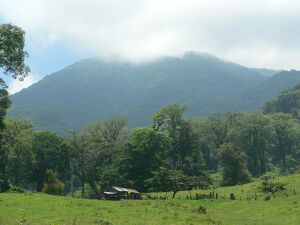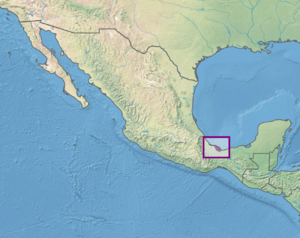Earth:Sierra de los Tuxtlas
| Sierra de los Tuxtlas | |
|---|---|
 Cloud-shrouded San Martin Tuxtla | |
 Location of the Sierra de los Tuxtlas | |
| Ecology | |
| Realm | Neotropical |
| Biome | tropical and subtropical moist broadleaf forests |
| Borders | Script error: No such module "Compact list". |
| Geography | |
| Area | 3,813 km2 (1,472 sq mi) |
| Country | Script error: No such module "Compact list". |
| States | Script error: No such module "Compact list". |
| Conservation | |
| Conservation status | Critical/endangered |
| Protected | 1,519 km² (40%)[1] |
The Sierra de Los Tuxtlas (Tuxtlas Mountains) are a volcanic belt and mountain range along the southeastern Veracruz Gulf coast in Eastern Mexico. The Los Tuxtlas Biosphere Reserve (Biósfera Los Tuxtlas) includes the coastal and higher elevations of the Sierra de Los Tuxtlas.
The volcanic mountains were used as a basalt source by the Olmec culture during the Early Formative period (1500 BCE to about 400 BCE). Quarried basalt was transported by raft through a network of rivers, to sites in the Olmec heartland for use in creating monuments, including colossal heads.[2]
Geography
Peaks in this range include Volcano Santa Marta and Volcano San Martín Tuxtla, both rising above 1,700 meters. San Martín Tuxtla is the only recently active volcano in the belt, erupting in 1664 and again in May 1793. It is a broad alkaline shield volcano with a one kilometer wide summit. Hundreds of smaller cinder cones are prevalent throughout the Sierra.
Other, extinct volcanoes include San Martin Pajapan (1,160 meters) and Cerro El Vigia (800 meters).
The Sierra de Los Tuxtlas volcanoes are an insular anomaly. The volcanoes are separated from the nearest volcano in the Trans-Mexican Volcanic Belt to the west by about 150 miles (250 km), and from the Central American Volcanic Belt to the southeast by almost 200 miles (330 km).
Natural history
The upper flanks of the San Martin Tuxtla and Santa Marta volcanoes are covered with the Neotropical Sierra de los Tuxtlas tropical rainforest ecoregion, of the tropical and subtropical moist broadleaf forests biome. The lower portions are covered with stunted pastures and grasslands.
The Tuxtla quail-dove (Zentrygon carrikeri) is endemic to the ecoregion.
The Volcan San Martin rainfrog, Craugastor vulcani, is an endangered frog endemic to rain and cloud forests of Sierra de los Tuxtlas.[3][4] The area is also home to an endemic species of giant scarab beetle, Dynastes moroni, described in 2005.[5]
See also
- List of ecoregions in Mexico
References
- ↑ Dinerstein, Eric et al. (June 2017). "An Ecoregion-Based Approach to Protecting Half the Terrestrial Realm". BioScience 67 (6): 534–545. doi:10.1093/biosci/bix014. PMID 28608869. Supplemental material 2 table S1b.
- ↑ Ancient Mexico and Central America
- ↑ Frost, Darrel R. (2014). "Craugastor vulcani (Shannon and Werler, 1955)". Amphibian Species of the World: an Online Reference. Version 6.0. American Museum of Natural History. http://research.amnh.org/vz/herpetology/amphibia/Amphibia/Anura/Craugastoridae/Craugastorinae/Craugastor/Craugastor-vulcani.
- ↑ Santos-Barrera, G. (2004). "Craugastor vulcani". IUCN Red List of Threatened Species 2004: e.T57050A11574639. doi:10.2305/IUCN.UK.2004.RLTS.T57050A11574639.en. https://www.iucnredlist.org/species/57050/11574639. Retrieved 10 January 2018.
- ↑ Ratcliffe, B. C., R. D. Cave, and E. Cano. 2013. The dynastine scarab beetles of Mexico, Guatemala, and Belize (Coleoptera: Scarabaeidae). Bulletin of the University of Nebraska State Museum 27: 1-666.
- Yarza de la Torre, Esperanza (1971). Volcanes de México. Aguilar. p. 237 pp. (in Spanish)
- "San Martín Pajapan". Smithsonian Institution. https://volcano.si.edu/volcano.cfm?vn=341830.
External links
 |

